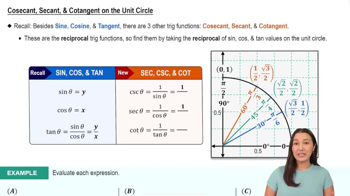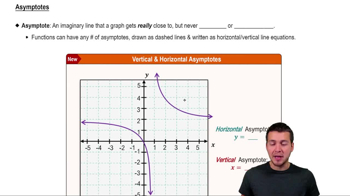Here are the essential concepts you must grasp in order to answer the question correctly.
Reciprocal Functions
Reciprocal functions are derived from basic trigonometric functions by taking the reciprocal of their values. For example, the cosecant function is the reciprocal of the sine function, defined as csc(x) = 1/sin(x), and the secant function is the reciprocal of the cosine function, defined as sec(x) = 1/cos(x). Understanding how these functions relate to their original counterparts is crucial for graphing and analyzing their behavior.
Recommended video:
Secant, Cosecant, & Cotangent on the Unit Circle
Graphing Trigonometric Functions
Graphing trigonometric functions involves plotting the values of the function over a specified interval, typically using key points such as maximums, minimums, and intercepts. The shape of the graph is influenced by the function's periodicity and amplitude. For reciprocal functions like cosecant and secant, the graphs will exhibit asymptotes where the original function equals zero, leading to undefined values in the reciprocal.
Recommended video:
Introduction to Trigonometric Functions
Asymptotes in Trigonometric Functions
Asymptotes are lines that the graph of a function approaches but never touches. In the context of reciprocal trigonometric functions, vertical asymptotes occur at the points where the original sine or cosine function equals zero, as these points correspond to undefined values for cosecant and secant. Recognizing the locations of these asymptotes is essential for accurately sketching the graphs of these reciprocal functions.
Recommended video:
 Blitzer 3rd Edition
Blitzer 3rd Edition Ch. 2 - Graphs of the Trigonometric Functions; Inverse Trigonometric Functions
Ch. 2 - Graphs of the Trigonometric Functions; Inverse Trigonometric Functions Problem 25
Problem 25 Verified step by step guidance
Verified step by step guidance


